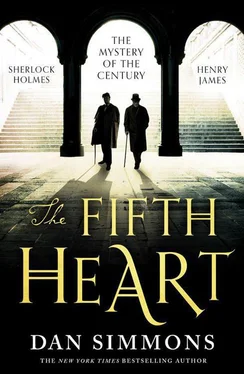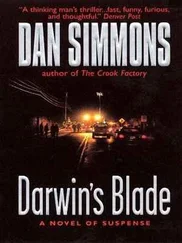Holmes glanced at the stars. It was not yet one a.m. He had time.
Once inside the kitchen, Holmes squatted for several minutes of absolute silence—controlling his breathing so that even he could not hear it—and did nothing but listen to the house. He’d heard both John and Clara Hay mention that Adams’s people were off at play for these final three days before they would regather and regroup to prepare the house for Henry Adams’s return on Friday, and Holmes’s instincts told him that the huge house was indeed empty.
He lit a hand lamp no larger than his palm and closed the upper and lower louvers so that it cast the dimmest of lights and that only straight ahead in a narrow beam. In a few minutes he’d reassembled the entire lock and doorknob apparatus, locked and bolted the back door from the inside again, and was stealing silently up the narrow steps of the servants’ rear staircase.
Although both houses had been designed in the so-called Romanesque style, Adams’s home had a different feeling on the inside and different proportions on the outside. Holmes had noted to James the profusion of towers, turrets, gables, and huge chimneys on the Hays’ home; the Adamses’ abode—dwelt in only by the widower and his staff now, of course—was simpler, more modern-looking from the outside, set off architecturally only by the twin white arches of its entrance.
Both homes were four stories tall, but the Adams house had a flat front. One of these rooms on the second floor was Henry Adams’s private study and Holmes found the locked door to it in no time. Next to the study, door also locked, was a room that had been Clover Adams’s combination darkroom and small photographic workshop and which now—according to Clara Hay—had been converted to archives for the dead woman’s carefully inventoried photographs.
The simple lock took Holmes less than a minute and then he was in the windowless inner archives room, re-lighting his louvered hand lamp and looking at the drawer upon drawer of photographic prints and plates.
He trusted in Henry Adams’s famous neatness and efficiency and was not disappointed. It had been Adams who had inventoried and archived most of Clover’s photographic images after her suicide in December of 1885. It took Holmes only a few minutes to find both the inventory journal—most of it typed out, some still in Henry Adams’s neat hand—and then the key to the specially constructed archival file cabinets.
Vol. 7—p. 24—#50.23—“R. Lorne, Feb., 1884”, the caption in Clover’s tighter script—“Rebecca Lorne, standing, in Roman costume”.
Holmes found and removed the photo and crouched low to prevent any escape of light as he played the beam of his hand-lantern over it.
The woman’s pose was awkward, the “Roman costume” amateurly made, and her face was turned two-thirds away from the camera. But there was no doubt at all that “Rebecca Lorne” was the woman Sherlock Holmes had known as Irene Adler. He set this photograph back in place.
Vol. 7—p. 9—#50.9—“R. Lorne”, no date given, caption in Clover’s hand—“Rebecca Lorne with banjo”. And also in Clover Adams’s hand— “Very good” .
Holmes turned the narrow beam on the image. It was a very good photograph of Irene Adler/Rebecca Lorne. The woman was older than Holmes remembered, but Adler was still quite attractive. Clover Adams had posed the woman in the corner of a room near a window, holding her banjo as if she were playing it. Holmes had seen that banjo before. Lorne’s/Adler’s face was turned toward the window and tilted slightly forward, catching the soft light. Clover had used a wide-angle lens—Holmes guessed it to be the Dallmeyer lens, new to photography about the time Clover died—and had achieved an image poised somewhere between a portrait and capturing an instant of everyday life.
Vol. 7—p. 10—#50.10—“R.H., Feb. 8, 1884”, date and the identical caption to the first photo Holmes had seen, also written in Clover’s hand—“Rebecca Lorne, standing, in Roman costume”. Again the face was turned mostly away from the camera. Holmes set it back.
Vol. 9—p. 17—#50.106—“Old Sweet Springs, Virginia, June, 1885, Rebecca Lorne, her cousin Clif Richards, H.A.”—“On piazza of house”.—The writing was all in Henry Adams’s careful hand.
Holmes removed his small magnifying glass and studied the image. Rebecca Lorne was looking at the camera with only the upper part of her face hidden by her bonnet, but her “cousin Clifton Richards” had lowered his head so that the brim of his hat hid all of his face. The form of the man was athletic-enough looking to be Lucan Adler, but one would never be sure. He put the photograph back in its archival setting.
Vol. 9—p. 21—#50.108—“Old Sweet”—captions written in Henry Adams’s hand—“View of house with people on piazza”. Again, part of “Rebecca Lorne’s” face was visible, but the man, still Clifton Richards from the clothing and hat, had turned his face full away.
Holmes swore under his breath. There was only one more photograph in this series.
Vol. 9—p. 23—#50.109—“Old Sweet Springs, June, 1885, Rebecca Lorne and Cousin”—all in Henry Adams’s careful script—“Standing in meadow with house in background”.
Clover had obviously taken this photograph with no warning to her subjects. The two figures stood in high grass that rose almost to their waists. “Rebecca Lorne’s” head and shoulders were a blur as she turned her head to hear something spoken by the man standing next to her and slightly behind her.
The man’s face—unaware that Clover was taking a photo—was in perfect focus. It was the single finest and clearest image of young Lucan Adler ever captured in a photograph.
Holmes’s heart was pounding. There were two identical prints in the archival sleeve. Holmes removed one of them, checked with his narrow-beam lantern to make sure that the face was as clear as in the top print, and put that photograph in his inner pocket above his heart. He set the other image back in the proper file and closed and locked the long archival drawers.
He was just leaving the room when he heard voices downstairs.
* * *
“ . . . rousting me out of bed in the middle of the night . . .” a man was saying in an angry voice.
“Not his fault the weather turned rough on the Atlantic . . .” another man, an older man, was saying.
“ . . . home two days early with no warning . . .” groused a third and younger man.
“Have to change the linens in the master bedroom, air everything out, check the towels and . . .” a woman was saying to another woman who kept interrupting with complaints about the late hour.
“The cable didn’t say what time in the morning Mr. Adams will be arriving,” came the older man’s deep voice again. “Let us have everything ready tonight and have everyone back and ready for inspection at seven in the morning. I’ve ordered Martin to deliver messages to the rest of the staff.”
“Damn,” whispered Holmes without actually saying the word aloud. He shut off his tiny lantern and tip-toed toward the rear staircase.
The servants—almost certainly the head butler and two other male under-butlers, the housekeeper and at least two of her staff—were coming up the main staircase. Obviously Henry Adams was returning several days early and his diligent staff was making sure everything would be ready for him in the morning.
“Damn,” Holmes mouthed again and slipped up the narrow servants’ staircase to the rear of the high third floor. With no carpet, the ancient wooden stairs creaked under his weight.
“Hear that?” one of the under-butlers cried from downstairs.
“If it’s a burglar, he’s going to get an unwelcome surprise,” came the head butler’s deep voice.
Читать дальше












